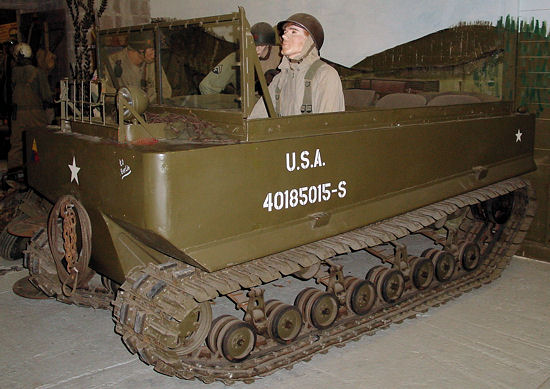CHAPTER III
Logistical Considerations
In spite of the inadequate road net re-supply of the 707th Tank Battalion became serious only in regard to Company A in KOMMERSCHEIDT. Companies B and C withdrew their platoons regularly from VOSSENACK and were able to effect re-supply with relative ease.
During the action at KOMMERSCHEIDT the battalion supply trains reached Company A twice: once on the night of 4-5 November and again on the following night. The trains consisted largely of 'weasels' which had been borrowed from the infantry, and even these versatile vehicles had difficulties with the MSR since they were pulling trailers. The trailers had to be unhitched and man-handled around the difficult turns of the MSR. Two way traffic was out of the question even though this road was the only route of medical evacuation for the troops south of the KALL. On both nights the troops of the tank battalion in KOMMERSCHEIDT received gasoline, ammunition, rations, water, and mail. On the second night part of the supply section including the S-4 and Headquarters Company commander who had accompanied him were cut off when the Germans moved onto the MSR. They subsequently took part in the withdrawal described in the account of Company A.

M29 WEASEL
It is interesting to note from a logistics as well as tactical point of view that Company B fired sustained indirect fire missions for a period of four days under the direction of the 28th Division Artillery. They were able to keep up their fire at a time when artillery ammunition to the division was rationed.
Evacuation of vehicles presented an unusual problem in that all of them had to be moved or repaired under fire. Under normal conditions the fighting has moved on when the maintenance crews conduct battlefield evacuation, but in the HURTGEN maintenance vehicles were vulnerable to the same enemy action that took toll of the tanks. The situation which developed, on the MSR between VOSSENACK and KOMMERSCHEIDT demanded the presence of maintenance vehicles, but the condition of the road as well as hostile artillery made it almost impossible for these vehicles to be used.
No mention is made in the combat interviews of the battalion medical detachment; therefore, it is assumed that evacuation of the wounded was through infantry installations. There is an occasional reference to tanks evacuating their own wounded, and Lt. Col. Ripple admits that in the withdrawal from KOMMERSCHEIDT many wounded were left behind because there was no way to get them out. Some were evacuated on improvised litters carried by soldiers who stripped themselves of their combat equipment to perform this task. Company A listed 32 men missing in this withdrawal and the infantry battalion listed about 150.
The experience in KOMMERSCHEIDT is a grim commentary on the importance of clearing, maintaining, and strongly securing a main route of supply and evacuation. Although the ground distance to division rear installations was relatively short, the defenders at SCHMIDT and KOMMERSCHEIDT were, in effect, divorced logistically from the division. The terrain in a large measure was responsible for this, although the action of the enemy certainly played its part. Thus another bitter lesson was learned on the battleground of the HURTGEN FOREST.

